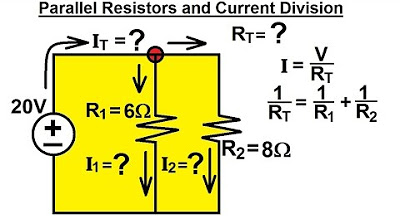Parallel Resistors (Full Lecture)
Summary
TLDRIn this lecture by Jim Pytel on Big Bad Tech, the concept of resistors in parallel is thoroughly explored. The session covers the basic principles, including how parallel configurations reduce total resistance and the formulas for calculating resistance in both two-resistor and multi-resistor setups. Pytel illustrates these concepts with practical examples, demonstrating the effects of adding resistors, as well as the implications of shorts and opens within circuits. The presentation emphasizes that the total resistance is always less than the smallest resistor and encourages viewers to reinforce their understanding through practice.
Takeaways
- 😀 Resistors in parallel provide multiple paths for current, reducing total resistance compared to a single resistor.
- 🔍 The total resistance of two resistors in parallel can be calculated using the formula: (R1 * R2) / (R1 + R2).
- 🔗 For any number of resistors in parallel, the total resistance can be found using the formula: 1/R_total = 1/R1 + 1/R2 + ... + 1/Rn.
- ⚡ The total resistance in parallel is always less than the smallest resistor in the configuration.
- 📉 Adding more resistors in parallel decreases the total resistance seen by the source.
- 🧮 Using the two-resistor formula helps simplify calculations when analyzing circuits with three or more resistors.
- 🛑 Open circuits remove the resistor from the circuit, affecting total resistance only by the remaining resistors.
- 🔌 Shorts create a zero-ohm path that can dominate current flow, effectively bypassing other resistors in parallel.
- 💡 The order of resistors in parallel does not affect the total resistance.
- ⚠️ Shorts in a circuit should be avoided as they can lead to dangerous levels of current flow.
Q & A
What is the main topic of the lecture?
-The main topic of the lecture is resistors in parallel, including their configurations and the effects of shorts and opens in parallel circuits.
What does a parallel configuration of resistors allow?
-A parallel configuration of resistors allows for multiple paths for current to flow, which effectively reduces the total resistance seen by the source.
What is the formula for calculating total resistance of two resistors in parallel?
-The formula for two resistors in parallel (R1 and R2) is: Total Resistance (R_total) = (R1 * R2) / (R1 + R2).
What is the more universal formula for calculating total resistance in any number of resistors in parallel?
-The universal formula states that 1/R_total = 1/R1 + 1/R2 + 1/R3 + ... for any number of resistors, and the final answer must be inverted to find R_total.
How does the total resistance of parallel resistors compare to the smallest individual resistor?
-The total resistance of a parallel combination of resistors is always less than the smallest resistor in that combination.
What happens to total resistance if more resistors are added in parallel?
-If more resistors are added in parallel, the total resistance decreases further, as more paths for current are available.
What influence do shorts have in parallel circuits?
-Shorts provide a low resistance path, which can divert current away from other resistors, effectively shorting out the entire parallel combination.
What is the effect of opens in parallel circuits?
-Opens (or breaks) in parallel circuits effectively remove only the opened element from consideration, allowing the remaining paths to continue functioning.
How does the arrangement of resistors in parallel affect total resistance?
-The arrangement of resistors in parallel does not influence total resistance; any configuration of the same resistors results in the same total resistance.
What is a key takeaway regarding the total resistance of identical resistors in parallel?
-For identical resistors in parallel, the total resistance can be calculated as the resistance value divided by the number of resistors.
Outlines

This section is available to paid users only. Please upgrade to access this part.
Upgrade NowMindmap

This section is available to paid users only. Please upgrade to access this part.
Upgrade NowKeywords

This section is available to paid users only. Please upgrade to access this part.
Upgrade NowHighlights

This section is available to paid users only. Please upgrade to access this part.
Upgrade NowTranscripts

This section is available to paid users only. Please upgrade to access this part.
Upgrade NowBrowse More Related Video

Series Resistors (Full Lecture)

Electrical Safety (OLD LECTURE)

Resistive circuits in series

Electrical Engineering: Basic Laws (14 of 31) Parallel Resistors and Current Division

Electrical Engineering: Basic Laws (17 of 31) Finding the Equivalent Resistor Ex. 2

Capacitive Complex Impedance (Full Lecture)
5.0 / 5 (0 votes)